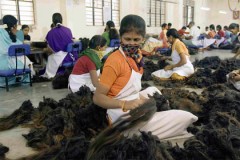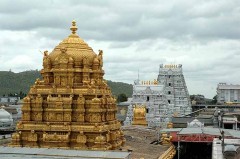01/06/2012
If hair is given to God and I buy a wig with this hair, am I God?
I have spoken a lot about hairs.
Hairs in the ears which is more developed in India than other countries (see: ). Hype rtrichosis.
rtrichosis.
Hairs that grow more in India due to the humid climate (see here).
Hairs that Sikh people let grow and put in a turban (see here).
Hairs that a cricket star shaved after winning a game (see here).
And I have probably mentioned it in other posts (here and there…).
And here a few words about the business of hairs.
”Many Indian women offer their hair to deities in Hindu temples in a show of (Click on “Lire la suite” to read more)
respect and gratitude.
The tradition of offering hair is a symbol of religious devotion and surrender of the ego.
Although both men and women offer their hair at temples, most of the hair that is exported for the lucrative salon business comes from women. Women's hair is usually long, dark and silky, and is most prized by merchants and wig-makers. Hair from men is usually used for coat linings and to extract L-Cystein, a protein used as raw material for a range of products including baby food and doughnuts.
There are four categories of hair:
The black hair and longer than 6 inches is the most sought after and sells for as much as $160 per kilogram.
The black hair, between 8 and 16 inches long, sells for around $44 a kilogram.
The black hair, shorter than 8 inches, sells for under a dollar a kilogram.
The gray hair shorter than 8 inches, sells for about 10 cents a kilogram.
Once exporters have bought hair they re-sort it into straight, wavy, silky and curly hair.
The hair is then shampooed, dried in the sun and combed.
 Every year hair worth about $136 million is shipped from India, one of the largest exporters of human hair, to factories in China. There, Chinese hair is mixed with Indian hair to make wigs and hair extensions for Western markets.
Every year hair worth about $136 million is shipped from India, one of the largest exporters of human hair, to factories in China. There, Chinese hair is mixed with Indian hair to make wigs and hair extensions for Western markets.
Hair worth $82 million was exported to the United States during the 2004-05 fiscal year, 30% more than the previous year.
Exporters say buyers from countries such as the United States pay $1.50 for a strand of hair that expensive beauty salons may then weave into extensions or wigs that can sell for between $1,500 and $3,000.
Hindu temples, where devotees tonsure their hair, are the largest hair suppliers. The top grosser is the famous temple in Tirupati, Sri Tirupati Balaji Venkateswara. Every year, over 9 million devotees stand in serpentine queues to pay obeisance to its deity and have their heads shorn to fulfill a vow or pledge. After the hair is collected, the temple stores it in 14 steel containers, with male and female hair kept separate. Once the warehouse is stocked, auction notices are advertised in four languages, al l south Indian, in three popular newspapers and on the temple's official Web site.
l south Indian, in three popular newspapers and on the temple's official Web site.
In 2005-06 financial year the temple sold over 3 million kilos of hair for about $1 million.
But this is only a small revenue for this temple. “The Tirupati temple generates average annual revenue of $120 million in cash, and tons of gold. It sees close to 70,000 devotees everyday. The temple is said to have 20 tonnes of gold and diamond jewellery and some of them date back to the 12th century. In 2009, a Karnataka minister Gali Janardhan Reddy had offered a diamond-studded crown worth Rs 42 crore ($7.8 million) to the God.”
Sources:
http://www.womensenews.org/story/business/060709/indian-temples-do-brisk-business-womens-hair
http://atimes.com/atimes/South_Asia/MG08Df02.html
http://zeenews.india.com/business/finance/tirupati-temple-to-get-rs-52k-cr-cover_12518.html
08:03 Posted in Incredible India! | Permalink | Comments (0) | Tags: india, hair, hair offering, hair business, shaving, tirupati temple, sri tirupati balaji venkateswara, gold | ![]() Facebook | |
Facebook | |















The comments are closed.